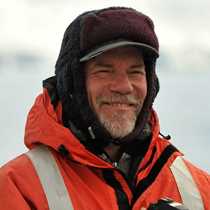The North Atlantic sweeps through the Faeroe Islands like raging rivers, churning into whitewater and whirlpools big and well-known enough to have names. Currents in the narrow channels frequently reach 8 knots and can be as high as 12, while overfalls, standing waves created where the current sweeps over shallow bottoms, can be as high as 40 feet!
Taking all this into account, I chose the better part of valor and enlisted the local expertise of a pair of Faroese dive guides, Janus and Danjal. They took me out from Torshavn on a bright beautiful afternoon and showed me a couple of their favorite dives. We stopped first at a reef in the middle of the channel between Torshavn and Esteroy where a refrigerator cargo ship had wrecked in the early 1980’s. Descending a very healthy rocky reef, we quickly found the wreck and spent most of the dive exploring it from bow to stern. Although the mid-ships area was quite broken up, both the bow and stern sections were in very good condition and the large prop was still present, heavily overgrown with corals, sponges and sea squirts. In fact, the life on the wreck was the best part of the dive. Small crabs scuttled over the hull, thousands of brittle stars waved their spiny arms in the gentle current and large sea cucumbers lifted their crowns of oral tentacles to feed on the plankton drifting by.
After a pleasant, sunny interval, we dove again in a lovely kelp forest on the east side of Esteroy. This habitat is dominated by Laminaria digitata, a species of kelp that grows only about three to six feet tall, so it lacks some of the grandeur of the giant kelp forests of California and Chile. Still, it is a very beautiful place, particularly with the rare Faeroe’s sun brightening the gold and green hues. We watched a school of whiting swim by and looked for nudibranchs (my favorite pastime), all the while accumulating more good video shots to share with the guests on the National Geographic Endeavor, so that they too could enjoy this beautiful underwater world. The Faroes are probably better known for their fierce weather and strong currents than for their diving, but these very currents bathe the islands in nutrients and nourish a little-known cold water diver’s paradise.
Taking all this into account, I chose the better part of valor and enlisted the local expertise of a pair of Faroese dive guides, Janus and Danjal. They took me out from Torshavn on a bright beautiful afternoon and showed me a couple of their favorite dives. We stopped first at a reef in the middle of the channel between Torshavn and Esteroy where a refrigerator cargo ship had wrecked in the early 1980’s. Descending a very healthy rocky reef, we quickly found the wreck and spent most of the dive exploring it from bow to stern. Although the mid-ships area was quite broken up, both the bow and stern sections were in very good condition and the large prop was still present, heavily overgrown with corals, sponges and sea squirts. In fact, the life on the wreck was the best part of the dive. Small crabs scuttled over the hull, thousands of brittle stars waved their spiny arms in the gentle current and large sea cucumbers lifted their crowns of oral tentacles to feed on the plankton drifting by.
After a pleasant, sunny interval, we dove again in a lovely kelp forest on the east side of Esteroy. This habitat is dominated by Laminaria digitata, a species of kelp that grows only about three to six feet tall, so it lacks some of the grandeur of the giant kelp forests of California and Chile. Still, it is a very beautiful place, particularly with the rare Faeroe’s sun brightening the gold and green hues. We watched a school of whiting swim by and looked for nudibranchs (my favorite pastime), all the while accumulating more good video shots to share with the guests on the National Geographic Endeavor, so that they too could enjoy this beautiful underwater world. The Faroes are probably better known for their fierce weather and strong currents than for their diving, but these very currents bathe the islands in nutrients and nourish a little-known cold water diver’s paradise.




